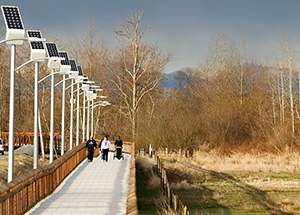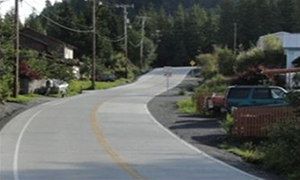
Tribal Case Studies Highlight Effective Intergovernmental Partnerships
The six Tribal transportation case studies on the
TPCB
Tribal Planning Focus Area web page are:
- The Sitka Fixed-Route Bus Transit System Case Study details the partnership between the Sitka Tribe of Alaska and the City and Borough of Sitka, Alaska, to develop “the RIDE” – a bus transit system that has improved accessibility and mobility for both Tribal and non-Tribal residents.
- The Jamestown S’Klallam U.S. 101 Case Study describes the Jamestown S’Klallam Tribe’s engagement with State and local agencies to develop a pedestrian tunnel under U.S. Highway 101 and a rest area at the Sequim Bay Scenic Pullout, including assistance with the National Environmental Policy Act process.
- The Ignacio Area Corridor Access Plan Case Study explains the development of a four-way partnership between the Southern Ute Indian Tribe, the Colorado
DOT, La Plata County, and the town of Ignacio to implement a corridor access plan for Colorado State Highway 172 to address existing and future mobility and safety needs for all roadway users.
- The Partnerships for Active Transportation Case Study focuses on a successful collaboration between the Cherokee Nation and the city of Collinsville, Oklahoma, to improve the health of Tribal members by promoting physical activity through improvements to transportation infrastructure.
- The Haxton Way Pedestrian Pathway Project Case Study demonstrates the value of partnership between Tribal, Federal, State, and county governments through the construction of a pedestrian pathway on Tribal lands in western Washington State.
- The Shtax’Heen Roadway Improvement Project Case Study describes how the relationship between an Alaskan Tribe and the City and Borough of Wrangell (CBW), Alaska, helped both agencies collaborate to make transportation improvements that benefit both the Tribe and the city.
The Federal Highway Administration (FHWA) is committed to building more effective day-to-day working relationships among Tribes, State Departments of Transportation (DOTs), metropolitan planning organizations (MPOs), and local governments. These relationships can result in more and better transportation projects on Tribal lands and can help to streamline the project development process. To this end, FHWA’s Tribal Transportation Planning website and the joint FHWA and Federal Transit Administration Transportation Planning Capacity Building (TPCB) Tribal Planning Focus Area web page provide resources for transportation professionals, both Tribal and non-Tribal, for transportation planning on Tribal lands. The Tribal Transportation Planning website offers planning modules for topics such as asset management and Tribal consultation. The TPCB Tribal Planning Focus Area web page offers Tribal news, regulations, policies, and training information, as well as a self-managed e-mail subscription service that allows users to receive regular updates. The web page also provides a series of case studies that outline noteworthy practices for the benefit of Tribes and their partners. These case studies demonstrate that partnerships between transportation agencies or local governments and Tribes can result in the successful delivery of much-needed transportation projects that benefit Tribal communities. This newsletter highlights six case studies that focus on innovative partnership practices between Tribes, State DOTs, MPOs, and other local partners, and explores two of these case studies in depth.
An Emphasis on Partnership
Partnerships between Tribal governments and Federal, State, and local government agencies allow these entities to work together to accomplish common goals, such as the construction of a new road or expansion of a local transit system. Partnerships allow Tribes to leverage relationships with these entities to make the most of limited transportation resources and increase Tribal knowledge of the transportation planning process. These partnerships establish stronger ties and trust among the participating Governments, Tribal DOTs, State DOTs, to each entity’s benefit.
The Tribal Transportation Planning website features six case studies that highlight examples where effective partnerships have facilitated efforts to improve mobility, accessibility, and livability on or near Tribal lands through new transit systems, pedestrian infrastructure investments, planning activities, and other measures. The six case studies are listed in the sidebar to the right. The Haxton Way Pedestrian Pathway Project and the Shtax’Heen Roadway Improvement Project case studies are explored below.

The Haxton Way pedestrian-bicycle trail improved pedestrian access and safety in the Lummi Nation. (Courtesy of the Lummi Nation)
The Haxton Way Pedestrian Pathway Project
Haxton Way, which traverses the Lummi Nation Reservation in western Whatcom County, Washington, provides connections between residential areas, the reservation’s general store, and a major employment center. The heavily-used road was a dangerous thoroughfare for walkers and cyclists due to the lack of sidewalks and bicycle lanes. The Lummi Nation initiated the Haxton Way Pedestrian Pathway Project to improve walking and bicycling conditions along the corridor.
The Lummi Nation Planning and Public Works Department (PPWD) partnered with Whatcom County, Washington State DOT (WSDOT), the Bureau of Indian Affairs, and FHWA to develop a multi-use trail along Haxton Way to address the corridor’s pedestrian and bicyclist safety issues. The partners capitalized on available funding from several sources, including Whatcom County, the Lummi Nation, the State’s Pedestrian and Bicycle Safety Program, the American Recovery and Reinvestment Act (ARRA), and FHWA’s Federal Lands Highway Coordinated Technology Implementation Program. The project involved the construction of a two-mile, $1.7 million paved pedestrian-bicycle trail with boardwalks, bridges, safe road crossings, and solar-powered lighting. Completed in 2010, the new trail has reduced vehicle, pedestrian, and bicycle conflicts, and has improved nonmotorized access and connectivity between employment centers, residential areas, and service providers.
The Lummi Nation PPWD and WSDOT actively engaged local residents and Tribal elders to shape the design and development of the trail, which resulted in a facility that meets the specific needs of the population it serves. The width of the trail, for example, accommodates multiple users side-by-side to encourage socialization, as requested by Tribal members.
The Haxton Way Pedestrian Pathway Project demonstrates the potential for the successful implementation of safety and quality-of-life improvements on Tribal lands through partnerships between States, counties, and Tribes. The Lummi Nation’s partnership with Whatcom County and other agencies enabled the Tribe to identify non-Tribal capital funding for the project while allowing the Tribe to guide the design and development of the trail according to the unique needs of its members. The benefits of this partnership are not restricted to the Tribe alone; Whatcom County, as the owner of Haxton Way, gained a safer roadway with fewer vehicle, pedestrian, and bicycle conflicts.

The top photo shows the roadway prior to the start of the Shtax’Heen Roadway Improvement Project. The bottom photo shows the completed roadway. (Courtesy of the WCA)
The Shtax’Heen Roadway Improvement Project
Over the past several years, the Wrangell Cooperative Association (WCA), a federally-recognized Tribe in Southeast Alaska, and the CBW have developed an effective working relationship that allows them to collaborate on transportation infrastructure projects. A memorandum of understanding (MOU) between the two organizations provides the framework for their partnership, including general guidelines for joint project development. In addition to this MOU, the WCA and the CBW develop memoranda of agreement (MOA) for each transportation infrastructure project that they undertake jointly. With WCA Tribal members comprising one sixth of the city’s residents, cooperation between the WCA and the CBW has resulted in projects of mutual benefit to the Tribe and the municipality.
Prior to the partnership, many WCA members lacked adequate paved roadway connections between a Tribal housing development and local workplaces and services. Because the surrounding roads were entirely on city-owned property, the Tribe needed to partner with the local government to fully pave the roadway. Under a project-specific MOA, the CBW and the Tribe agreed that the WCA would be responsible for the design, construction, and funding of the project and the CBW would be responsible for design review, project oversight, and regular road maintenance upon project completion. The two entities worked together to develop the Shtax’Heen Roadway Improvement Project in 2011. With funding from the Indian Reservation Roads Program and ARRA, the partners coordinated the reconstruction of the roadway to include two paved 12-foot vehicle lanes and one 6-foot pedestrian walkway, which provide access to and from the local Tribal housing development for drivers and pedestrians.
The Shtax’Heen Roadway Improvement Project yielded benefits for both the Tribe and the city; WCA benefited from improved roadways on Tribal lands and the city gained new transportation corridors, without incurring construction costs. The success of this project has inspired additional collaboration and MOAs between the Tribe and CBW. Their continued partnership demonstrates that they have recognized the benefits of effective collaboration.
Case Studies Demonstrate Success in Tribal Transportation Planning
These Tribal transportation planning case studies demonstrate the positive outcomes that can result from successful partnerships between Tribes and government agencies at the Federal, State, regional, and local levels. The Tribes featured in these case studies have been able to secure meaningful benefits for their members, including improvements in quality of life, accessibility, mobility, public health, and pedestrian and driver safety. The State, regional, and local partners featured in these case studies have guaranteed improvements to transportation infrastructure that better serve the needs of the traveling public. The new Haxton Way Pedestrian Pathway in Whatcom County, Washington, for example, has contributed to lasting improvements in the mobility, safety, and accessibility of Tribal and non-Tribal roadway users in that community. To achieve these outcomes, the Tribes and their partners capitalized on available grant funding; developed MOUs, MOAs, and other partnership agreements; and coordinated with Tribal members to assess local needs. These case studies may serve as resources for professionals active in Tribal transportation planning.
In addition to these six case studies, FHWA is developing four additional case studies that will highlight effective practices in the Tribal transportation consultation process. They will be posted on the TPCB Tribal Planning Focus Area web page later this year.
Contact Information
Michelle Noch
Office of Planning
Federal Highway Administration
(202) 366-9206
michelle.noch@dot.gov
Theresa Hutchins
Office of Planning
Federal Highway Administration
(360) 753-9402
theresa.hutchins@dot.gov
Look What’s New!
- FHWA recently announced the winners of the 2013 Environmental Excellence Awards (EEA). The 13 awards recognize achievement in categories such as Cultural and Historic Resources; Ecosystems, Habitat, and Wildlife; Environmental Streamlining (Every Day Counts); and Programmatic Agreements. Visit the EEA website to learn more about the awards and recipients.
- FHWA’s Eco-Logical website has been updated with new information about Implementing Eco-Logical, research under the Second Strategic Highway Research Program. The Implementing Eco-Logical web page provides information on 13 agencies that have received grants to advance the implementation of Eco-Logical across the country.
Successes in Stewardship is a Federal Highway Administration newsletter highlighting current environmental
streamlining and stewardship practices from around the country. Click here to subscribe to the newsletter, or call 617-494-2092 for more information.

